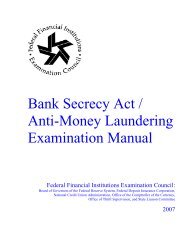FFIEC Annual Report 1999
FFIEC Annual Report 1999
FFIEC Annual Report 1999
Create successful ePaper yourself
Turn your PDF publications into a flip-book with our unique Google optimized e-Paper software.
appointed by the President, with the<br />
advice and consent of the Senate,<br />
for six-year terms. One of the three<br />
directors is designated by the President<br />
as Chairman for a term of five<br />
years, and another is designated<br />
as Vice Chairman. The other two<br />
Board members are the Comptroller<br />
of the Currency and the Director of<br />
the Office of Thrift Supervision. No<br />
more than three Board members<br />
may be of the same political party.<br />
The FDIC’s supervisory activities<br />
are conducted by the Division of<br />
Supervision (DOS) and the Division<br />
of Compliance and Consumer Affairs<br />
(DCA). Each of these divisions<br />
is organized into eight regional<br />
offices headed by a DOS regional<br />
director and a DCA regional director.<br />
Bank liquidation activities are<br />
handled by the Division of Resolutions<br />
and Receiverships.<br />
The FDIC administers two federal<br />
deposit insurance funds: the Bank<br />
Insurance Fund (BIF) and the Savings<br />
Association Insurance Fund<br />
(SAIF). The basic insured amount<br />
for a depositor is $100,000 at each<br />
insured depository institution. The<br />
BIF is funded through assessments<br />
paid by insured commercial banks,<br />
certain federal and state savings<br />
banks, and industrial banks, as well<br />
as through income from investments<br />
in U.S. government securities.<br />
The SAIF, which was created in<br />
1989 as a successor to the former<br />
Federal Savings and Loan Insurance<br />
Corporation (FSLIC), receives<br />
assessment premiums from insured<br />
savings associations. SAIF assessment<br />
rates and BIF assessment rates<br />
are currently the same—ranging<br />
from zero to 27 cents for every $100<br />
of assessable deposits, depending<br />
on the degree of risk to the respective<br />
deposit insurance fund.<br />
Any depository institution that<br />
receives deposits may be insured<br />
by the FDIC after application to and<br />
examination and approval by the<br />
FDIC. After considering the<br />
applicant’s financial history and<br />
condition, adequacy of the capital<br />
structure, future earnings prospects,<br />
24<br />
general character of the management,<br />
risk presented to the insurance<br />
fund, convenience and needs of<br />
the community to be served, and<br />
consistency of corporate powers,<br />
the FDIC may approve or deny an<br />
application for insurance. FDICIA<br />
expanded the FDIC’s approval<br />
authority to include national banks,<br />
all state-chartered banks that are<br />
members of the Federal Reserve<br />
System, and federal and statechartered<br />
savings associations.<br />
The FDIC has primary federal regulatory<br />
and supervisory authority<br />
over insured state-chartered banks<br />
that are not members of the Federal<br />
Reserve System, and it has the<br />
authority to examine for insurance<br />
purposes any insured financial institution,<br />
either directly or in cooperation<br />
with state or other federal<br />
supervisory authorities. FDICIA<br />
gives the FDIC back-up enforcement<br />
authority over all insured institutions;<br />
that is, the FDIC can recommend<br />
that the appropriate federal<br />
agency take action against an<br />
insured institution and may do so<br />
itself if deemed necessary.<br />
In protecting insured deposits, the<br />
FDIC is charged with resolving the<br />
problems of insured depository<br />
institutions at the least possible cost<br />
to the deposit insurance fund. In<br />
carrying out this responsibility, the<br />
FDIC engages in several activities,<br />
including paying off deposits,<br />
arranging the purchase of assets<br />
and assumption of liabilities of<br />
failed institutions, effecting insured<br />
deposit transfers between institutions,<br />
creating and operating temporary<br />
bridge banks until a resolution<br />
can be accomplished, and using its<br />
conservatorship powers.<br />
National Credit Union<br />
Administration (NCUA)<br />
The NCUA, established by an act of<br />
Congress in 1934, is the agency that<br />
heads the nation’s federal credit<br />
union system. A three-member<br />
bipartisan board appointed by the<br />
President for six-year terms man-<br />
ages the NCUA. The President also<br />
selects a member to serve as Chair<br />
of the board.<br />
The main responsibilities of the<br />
NCUA are the following:<br />
charters, examines, and supervises<br />
more than 6,500 federal<br />
credit unions nationwide<br />
administers the National Credit<br />
Union Share Insurance Fund<br />
(NCUSIF), which insures 96 percent<br />
of member share accounts in<br />
nearly 11,300 U.S. federal and<br />
state-chartered credit unions<br />
manages the Central Liquidity<br />
Facility, a central bank for credit<br />
unions, which provides liquidity<br />
to the credit union system.<br />
The NCUA also has statutory<br />
authority to examine and supervise<br />
NCUSIF-insured, state-chartered<br />
credit unions in coordination with<br />
state agencies.<br />
The NCUA has six regional offices<br />
across the United States that administer<br />
its responsibility to charter and<br />
supervise credit unions. Its examiners<br />
conduct annual, on-site examinations<br />
of each federal credit union.<br />
The NCUA is funded by the credit<br />
unions it regulates and insures.<br />
Office of the Comptroller of the<br />
Currency (OCC)<br />
The OCC is the oldest federal bank<br />
regulatory agency, having been<br />
established as a bureau of the Treasury<br />
Department by the National<br />
Currency Act of 1863. It is headed<br />
by the Comptroller, who is<br />
appointed to a five-year term by<br />
the President with the advice and<br />
consent of the Senate. The Comptroller<br />
also serves as a Director of the<br />
Federal Deposit Insurance Corporation<br />
and as a Director of the Neighborhood<br />
Reinvestment<br />
Corporation.<br />
The OCC is the charterer, regulator,<br />
and supervisor of the national banking<br />
system. As such, it currently<br />
regulates and supervises approxi-
















